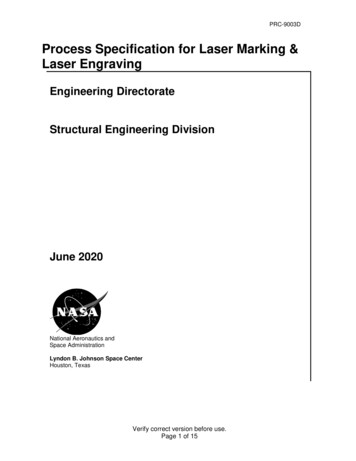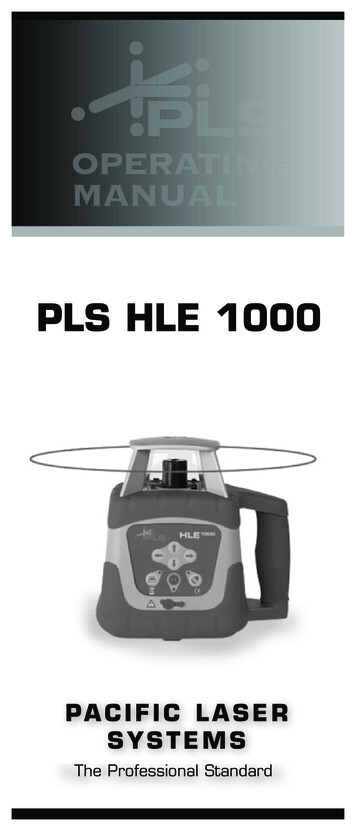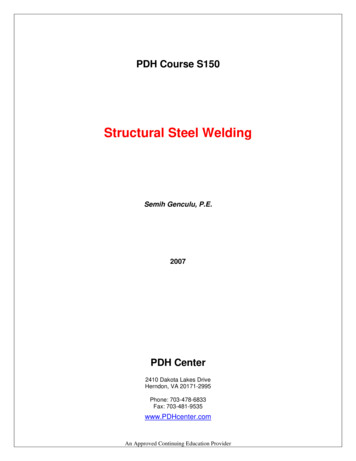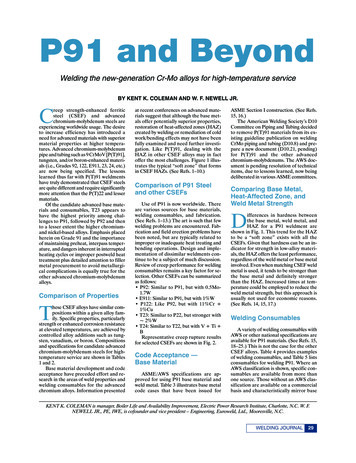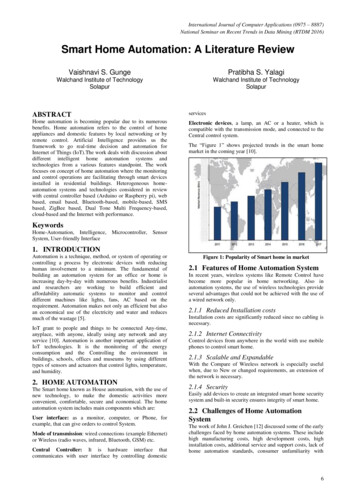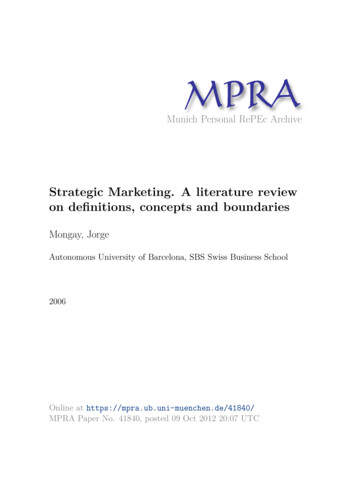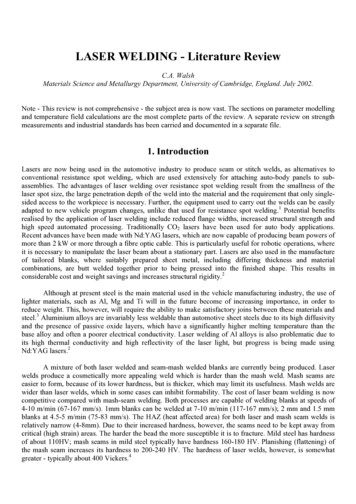
Transcription
LASER WELDING - Literature ReviewC.A. WalshMaterials Science and Metallurgy Department, University of Cambridge, England. July 2002.Note - This review is not comprehensive - the subject area is now vast. The sections on parameter modellingand temperature field calculations are the most complete parts of the review. A separate review on strengthmeasurements and industrial standards has been carried and documented in a separate file.1. IntroductionLasers are now being used in the automotive industry to produce seam or stitch welds, as alternatives toconventional resistance spot welding, which are used extensively for attaching auto-body panels to subassemblies. The advantages of laser welding over resistance spot welding result from the smallness of thelaser spot size, the large penetration depth of the weld into the material and the requirement that only singlesided access to the workpiece is necessary. Further, the equipment used to carry out the welds can be easilyadapted to new vehicle program changes, unlike that used for resistance spot welding.1 Potential benefitsrealised by the application of laser welding include reduced flange widths, increased structural strength andhigh speed automated processing. Traditionally CO2 lasers have been used for auto body applications.Recent advances have been made with Nd:YAG lasers, which are now capable of producing beam powers ofmore than 2 kW or more through a fibre optic cable. This is particularly useful for robotic operations, whereit is necessary to manipulate the laser beam about a stationary part. Lasers are also used in the manufactureof tailored blanks, where suitably prepared sheet metal, including differing thickness and materialcombinations, are butt welded together prior to being pressed into the finished shape. This results inconsiderable cost and weight savings and increases structural rigidity.2Although at present steel is the main material used in the vehicle manufacturing industry, the use oflighter materials, such as Al, Mg and Ti will in the future become of increasing importance, in order toreduce weight. This, however, will require the ability to make satisfactory joins between these materials andsteel.3 Aluminium alloys are invariably less weldable than automotive sheet steels due to its high diffusivityand the presence of passive oxide layers, which have a significantly higher melting temperature than thebase alloy and often a poorer electrical conductivity. Laser welding of Al alloys is also problematic due toits high thermal conductivity and high reflectivity of the laser light, but progress is being made usingNd:YAG lasers.2A mixture of both laser welded and seam-mash welded blanks are currently being produced. Laserwelds produce a cosmetically more appealing weld which is harder than the mash weld. Mash seams areeasier to form, because of its lower hardness, but is thicker, which may limit its usefulness. Mash welds arewider than laser welds, which in some cases can inhibit formability. The cost of laser beam welding is nowcompetitive compared with mash-seam welding. Both processes are capable of welding blanks at speeds of4-10 m/min (67-167 mm/s). 1mm blanks can be welded at 7-10 m/min (117-167 mm/s); 2 mm and 1.5 mmblanks at 4.5-5 m/min (75-83 mm/s). The HAZ (heat affected area) for both laser and mash seam welds isrelatively narrow (4-8mm). Due to their increased hardness, however, the seams need to be kept away fromcritical (high strain) areas. The harder the bead the more susceptible it is to fracture. Mild steel has hardnessof about 110HV; mash seams in mild steel typically have hardness 160-180 HV. Planishing (flattening) ofthe mash seam increases its hardness to 200-240 HV. The hardness of laser welds, however, is somewhatgreater - typically about 400 Vickers.4
1.1 Laser Welding SystemsThere are a number of different laser welding systems available. CO2 and Nd:YAG lasers are alreadyin use in industry. Low power Nd:YAG lasers are used in the electronics industry. Rapid improvements intechnology mean that diode lasers of sufficiently high power and power density for the production of gooddeep penetration welds are now available.1.1.1 CO2 lasersThese operate on a wavelength of 10.6µm and have a power range 1.5 - 6 kW, although some workat continuous power levels of 10kW and beyond. The energy absorption of the laser beam by metals is low,with an overall efficiency of up to 15%, although the energy transfer efficiency from the laser beam to theworkpiece can be as much as 0.8.5 The optical system consists of mirrors and ZnSe lenses. These lasers areused for sheet welding at high weld speeds.6,71.1.2 Nd:YAG solid-state laserThe operating wavelength is 1.06µm. Most have average powers of several hundred Watts withpulses of peak power 1-10 kW (although 1000 kW is possible). Lasers with continuous powers of up to 3kWare now commercially available. Metals also have a higher surface absorptivity at this lower wavelength.Their overall efficiency is about 3-5%. Unlike CO2 lasers, the beam can be guided through flexible glassfibres, due to its smaller wavelength. This makes it attractive for 3-d operations combined with articulatedarm type robots, providing greater flexibility, accessibility and lower costs. In comparison CO2 lasers haveto use a complicated mirror system. The optical lenses and fibre optics provide a source of well defined sizeand angular radiating cone, with an even (top-hat) energy distribution, in contrast to the gaussian energydistribution associated with a CO2 laser source coupled to a mirror-based delivery system. Mechanical orelectro-optical deflectors can be used to deflect or multiplex a beam to several locations; dielectric beamsplitters allow the energy to be split for simultaneous action; all in combination with the use of optical fibresfor relaying the (sub-)beam to the place of work. Simultaneous spot welding by Nd:YAG lasers has foundwide use in the electronics industry; it is highly efficient and has the inherent advantage of minimisingdistortion and stress in the finished product.6,7,8 It is also possible to shape the temporal power profile of eachpulse at pulse repetition rates of up to several kHz.91.1.3 Excimer gas lasersThese operate in the UV region (e.g. 248nm and 193nm). They have efficiencies of 2-4% andproduce short pulses (tens of nanoseconds duration) and very high peak powers (above 107 W). Theproduction of a suitable optical system is difficult as there are few materials which are transparent toradiation at these wavelengths. The lifetime of the optical elements is low. They typically emitapproximately rectangular beams of aspect ratio 2:3 and low beam quality (K 0.01) in both directions. It isnot easy to focus the beam to a small spot. Such lasers have been used in lithography.6 [Beam quality can bedefined in terms of the K-factor. The minimum theoretical diameter ro (of a focused gaussian laser beam) isgiven in terms of K, the focal length f and aperture D of the focusing optics and the wavelength of the laserlight ! asK is 1 for a gaussian beam and less than 1 for other beam modes. Analogous systems uses the M2 notationwhere M2 1/K.]1.1.4 Diode lasersThese lasers operate on a wavelength in the near infra-red region of the spectrum (e.g. 808nm),which is an advantage of these lasers when compared with the CO2 or Nd:YAG lasers, as many metallicmaterials used in industry, such as Al, have a higher absorption coefficient in this region.10 They haveefficiencies of up to 50%. To produce high power beams it is necessary to shape and combine radiation froma large number of emitting diodes. This has necessitated the development of suitable optical systems,incorporating micro-optical elements and diffractive optical elements.6 Currently available diode lasers havepowers in the kW range (up to 2.5kW), but have a lower beam quality when compared with the CO2 and
Nd:YAG lasers. Further improvements in power and beam quality are needed to improve their capability fordeep penetration welding. The apparatus for high power diode lasers, however, is very compact. A multi-kWlaser head is only the size of a shoe-box.3 This lower weight and compact size of diode lasers gives them amajor advantage over with the traditional CO2 and Nd:YAG lasers; it enables them to be mounted directlyonto robots and moved around easily. They also have lower cooling requirements and a higher lifetime (eachdiode: 5000-10000 hours). The size of this system is primarily limited by the size of the required coolingsystem and will not be significantly affected by further improvements in the semiconductor technology.10 Atable comparing CO2, Nd:YAG and diode laser characteristics is given in reference 11.1.2 The Laser Welding ProcessWhen welding with a laser beam, it is necessary to differentiate between two forms of welding: heatconduction welding and deep penetration welding. Conduction welding occurs at lower power densities orhigher welding speeds. The absorbed energy is transferred by heat conduction into the volume of theworkpiece and produces a broad, shallow pool of molten material. In deep penetration welding, the laserbeam is focused to a small spot and the power density can exceed 5x106 Watts/m2. Sufficient energy is inputto vaporise the material and a vapour-filled channel is formed through which the laser energy penetratesdeep into the workpiece. Deep seams are produced which increase the absorption efficiency and makegreater use of the laser beam. The energy required to melt and vaporise the material depends on the physicalproperties of the material (absorption coefficient, heat conduction), the wavelength of the laser light and theproperties of the surface of the workpiece. These welds typically have deep, narrow weld profiles, a smallHAZ and little distortion.12 As a result of the better energy utilisation and larger depth to width ratios ofwelds attainable with deep penetration welding, this is the prime method of welding used in industry withthe conventional laser sources.The laser beam has also been used to carry out other heat processes with materials: surfacehardening; alloying and vapour deposition, which do not involve melting of the material and require lowerpower densities; drilling and cutting, at even higher power densities where material ablation occurs,resulting in the formation of holes and slits in a material. Typical power densities used for each of theseprocesses are13:Surface hardeningChemical vapour depositionSurface alloying and claddingSurface melting and weldingDrilling and ablation-103-104 Wcm-2103-104 Wcm-2105-106 Wcm-2105-107 Wcm-2 107 Wcm-21.3 Physics of Laser Welding1.3.1 Conduction mode weldingHeat is absorbed from the laser beam through the top surface of the metal. Steady state conditions arereached quickly ( 2.5ms). The heat input is balanced by losses through the metal by conduction. The aspectratio of the weld is determined by thermal conduction and surface-tension-driven fluid flow in the weldpool. As the surface tension decreases with temperature, outward flow of the molten metal occurs.14Penetration depths are determined by heat conduction and convection in the weld pool.1.3.2 Deep penetration mode weldingA high energy-density laser beam vaporises the workpiece during the welding process to form a hole(keyhole), which allows the laser beam to penetrate into the metal to produce a deep, narrow melt pool. Theabsorption of the laser beam increases drastically once the keyhole has formed, as multiple reflections of thelaser light occurs within the hole until most has been absorbed by the metal. Only a fraction (typically 0.50.8) of the absorbed energy causes melting of the metal to occur, the rest is dissipated by thermal conductioninto the base of the metal, radiation, or convection in the melt pool.15 [Marangoni convection, or surface-
tension-driven convection, occurs in the melt pool. Fluid flows outwards from the centre of the weld poolalong the upper surface to the outside edge and returns below the surface. Increasing beam power makes thefluid flow shallower but faster. Decreasing the beam diameter makes the flow deeper and faster.16] Theamount of heat lost in these ways is a determining factor in the ultimate penetration depth of the weld. Atlow travel speeds the conduction loss through the base metal is very large.15The pressure of the vapour in the keyhole contributes to the penetration by stabilising the keyholeand keeping it open for further penetration, while the surface tension tends to close it at the surface. At lowtravel speeds, however, the vapour cavity tends to collapse resulting in reduced penetration. A plasma formsabove the surface of the workpiece due to the interaction of the laser beam with the metal vapour and alsowith atoms in the shielding gas. This absorbs laser beam energy, thus lowering the maximum attainable weldpenetration. The plasma also acts like a lens and degrades the optical quality of the laser beam.17A keyhole cavity is formed only if the beam is sufficiently intense. It is filled by gas or vapour,created by continuous evaporation of the material by the beam. The absorption of energy depends on thedegree of ionisation and density and hence on the temperature. At low temperatures the absorptioncoefficient is proportional to the degree of ionisation and increases rapidly with temperature. At highertemperatures ionisation is essentially complete and the absorption coefficient decreases with increasingtemperature, as a result of the lower electron and ion densities. This absorption is by inverseBremsstrahlung. So at low beam intensities beam penetration is limited, whereas at high beam intensities thepenetration grows with beam power.181.4 A Good WeldA good weld is crack-free and has high strength and reliability.19 Pore formation and alloyingelement loss are important concerns in laser welding of automotive aluminium alloys and must beminimised.20 The size and shap
The heat input is balanced by losses through the metal by conduction. The aspect ratio of the weld is determined by thermal conduction and surface-tension-driven fluid flow in the weld pool. As the surface tension decreases with temperature, outward flow of the molten metal occurs.14 Penetration depths are determined by heat conduction and convection in the weld pool. 1.3.2 Deep penetration .
